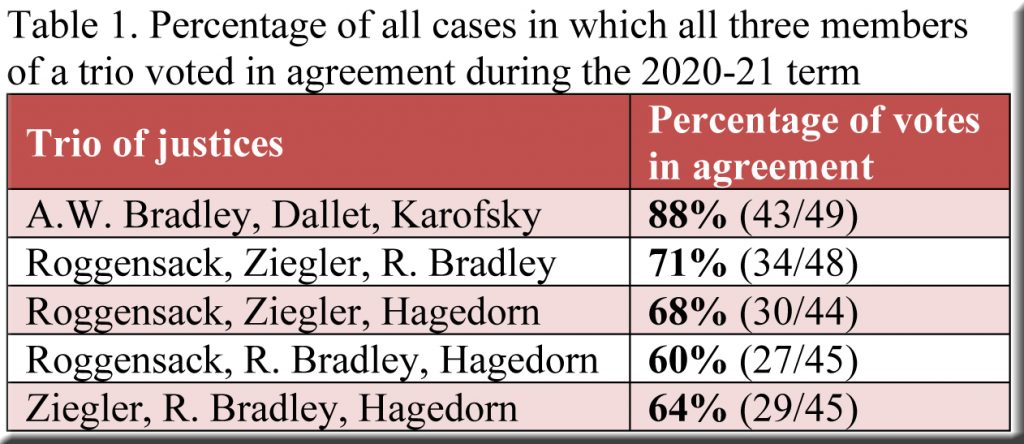Judge Jill Karofsky’s electoral victory over incumbent Justice Daniel Kelly last year prompted a post speculating on the impact that this might have during the court’s 2020-21 term. More specifically, the post focused on 4-3 decisions and the greater importance of “bloc cohesion” for conservative (and liberal) justices in determining the outcomes. With their number reduced to four, the conservatives could no longer afford to have one of their members stray in contentious cases—while the liberal minority, now three strong, had a more realistic chance to prevail in such cases, if they could maintain firmer unity in their ranks than did their conservative colleagues.
How did it turn out? Well, one way to study the distribution of votes in the 2020-21 term’s unusually large number of 4-3 decisions is to compare the strength of bloc cohesion among the three liberal justices (A.W. Bradley, Dallet, and Karofsky) with the cohesion among all sets of three conservative justices (Roggensack, Ziegler, R. Bradley, and Hagedorn). The difference is significant, even when we consider all decisions (including those that were unanimous). As shown in Table 1, the three liberals almost always voted together—either all in the majority or all dissenting 88% of the time—more frequently than any trio of conservatives.[1]
When we confine our gaze to non-unanimous cases (Table 2), the bloc-cohesion disparity between the liberals and conservatives is particularly striking. While the percentage for the three liberals slipped only from 88% to 82%, the decline was far more precipitous for the various combinations of conservatives—who struggled, and sometimes failed, to reach agreement in even half of these decisions.
Table 3, which focuses just on 4-3 decisions, indicates powerful accord among the three liberals—and also among three of the conservatives (Justices Roggensack, Ziegler, and R. Bradley). However, the remaining entries in the table highlight the challenge that they faced in assembling a majority in 4-3 cases, as Justice Hagedorn was much less inclined to fall in step.
The figures in one of our July posts, showing the assorted 4-3 majorities, correspond with what we have found here. The more reliable unity of the liberals goes some distance in accounting for the fact that they prevailed (along with one conservative, most often Justice Hagedorn) in seven of the 4-3 cases—only two fewer than the number of majorities formed entirely by the four conservatives.[2] This is nowhere close to the dominance that the conservatives enjoyed in 4-3 cases during the 2019-20 term, when they constituted the complete majority in eight of the eleven 4-3 (and one 3-2) decisions.[3]
[1] If one or more members of a trio did not participate in a case (which was rare), that case was not counted. Hence the differing number of cases in the tables.
[2] There were three other 4-3 decisions from 2020-21, two of whose majorities were equally divided between liberals and conservatives, and one whose majority contained three conservatives.
[3] Along with the eight cases in which they formed the entire majority, conservatives represented half the majority in the three remaining 4-3 decisions in 2019-20.



Speak Your Mind